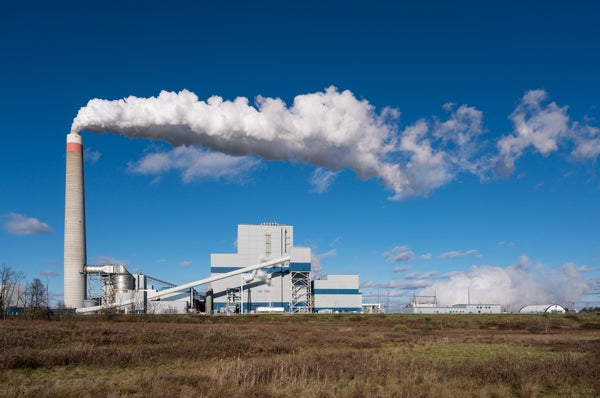EPA’s proposed replacement for the Obama-era Clean Power Plan could lead to increases in carbon emissions in 2030 compared with having no climate rule in place at all, a new study has found.
The proposed Affordable Clean Energy rule’s focus on cutting emissions through efficiency improvements could cause emissions to increase at 28 percent of regulated power plants, as more efficient plants run more frequently and states delay retirement of older, dirtier plants, according to the study.
This phenomenon—known as the emissions “rebound effect”—was one environmental and public health groups had warned of following the rule’s announcement in August.
On supporting science journalism
If you're enjoying this article, consider supporting our award-winning journalism by subscribing. By purchasing a subscription you are helping to ensure the future of impactful stories about the discoveries and ideas shaping our world today.
The researchers from Harvard University, Syracuse University and Resources for the Future found the rule would lead to “substantial variation” in carbon emissions among states. Eighteen states and Washington, D.C., would see higher emissions. Of those, Maryland would have the highest percentage increase: an 8.7 percent uptick in 2030.
“It’s sort of an astonishing outcome for a re-draft of a regulation,” said Dallas Burtraw, senior fellow at Resources for the Future and the report’s co-author.
The study’s publication comes as acting EPA Administrator Andrew Wheeler prepares for his confirmation hearing today before the Senate Environment and Public Works Committee. Democrats are likely to press Wheeler, who’s making his case to be permanent head of EPA, on the agency’s continued push to rewrite Obama-era rules.
The ACE rule is a marked departure from the 2015 Clean Power Plan, which took a systems-based approach to cutting carbon from the power sector. The Trump EPA’s proposal instead focuses on power plants making efficiency improvements at the facility level. It does not provide specific emissions reductions targets, giving states broad leeway to decide how much carbon-cutting they consider reasonable within the power sector.
The resulting rule is expected to lead to higher carbon emissions than the Clean Power Plan, with emissions reductions nationwide only slightly more than what would occur with no rule in place at all.
Foes of the Trump administration have widely criticized the proposal for failing to drive aggressive emissions reductions. Mounting scientific evidence, including from the U.N. Intergovernmental Panel on Climate Change, has shown the need to slash fossil fuel use across the globe as quickly as possible to forestall catastrophic climate impacts.
An EPA spokesman argued the ACE rule would reduce greenhouse gas emissions by 34 percent compared with 2005 levels.
“CPP did not result in any reduction in CO2 because it was legally problematic and stayed by the U.S. Supreme Court. ACE on the other hand would continue to reduce emissions across the nation,” John Konkus, deputy associate administrator for public affairs, said in an email.
“Many states have already taken a number of actions to improve their GHG emissions profile. Once the ACE rule is finalized, we have three years to work with states to continue to make these reductions as they develop their implementation plans,” he added.
In their new study, the researchers zeroed in on the agency’s regulatory impact analysis for the rule, which laid out projections for emissions reductions. They point out that while EPA briefly acknowledged the potential for a rebound effect, its modeling did not estimate how large that effect could be.
“Since ACE doesn’t mandate a carbon emissions rate, it gives the electricity sector a free pass on emissions, we weren’t too surprised that this is the outcome. It’s pretty much a recipe for increasing carbon emissions in some regions going forward,” said Kathleen Fallon Lambert, senior adviser at Harvard’s Center for Climate, Health and the Global Environment (C-CHANGE) and a co-author of the paper.
For 14 states, increased generation from coal-fired power plants would be a big driver of emissions. California, Georgia, Massachusetts, Oregon and D.C. would see heightened emissions from increases in natural gas use.
Lambert noted the study’s modeling assumes electricity demand will remain constant. But a separate preliminary report by the Rhodium Group recently found an increase in electricity demand last year, leading to a 1.9 percent increase in emissions from the power sector.
“We think these numbers are probably a bit overly optimistic,” Lambert said.
The researchers also found the plan could lead to increased emissions of sulfur dioxide and nitrogen oxides. Nineteen states would see increases in SO2 by 2030 under ACE, while 20 states and D.C. would see increases in NOx.
“These pollutants contribute to PM 2.5 [fine particles] and ozone, with health effects including increased risk of premature death, respiratory disease, heart attack and some neuro-cognitive diseases as well,” said Jonathan Buonocore, research associate at C-CHANGE and another co-author of the paper.
The researchers questioned how a proposal that would lead to increased emissions in 28 percent of power plants could represent a plan that meets the legal standards of the “best system of emissions reductions” under the Clean Air Act.
“This is a policy-driven decision to back away from the approach of the Clean Power Plan and use a source-based approach, with a perverse outcome. This rule seems inadequate for achieving its intended purposes,” Burtraw said.
He noted EPA could address the rebound effect by requiring power plants to at least maintain their current level of carbon emissions.
The researchers said the rule would make it even harder for specific states with emissions targets to meet their goals and for the United States to meet emissions reductions targets laid out in the Paris Agreement.
“A rule like ACE could lock us in an energy pathway that’s dependent on fossil fuels and slow the transition to renewable energy and energy efficiency,” Lambert said.
Reprinted from Climatewire with permission from E&E News. E&E provides daily coverage of essential energy and environmental news at www.eenews.net.
